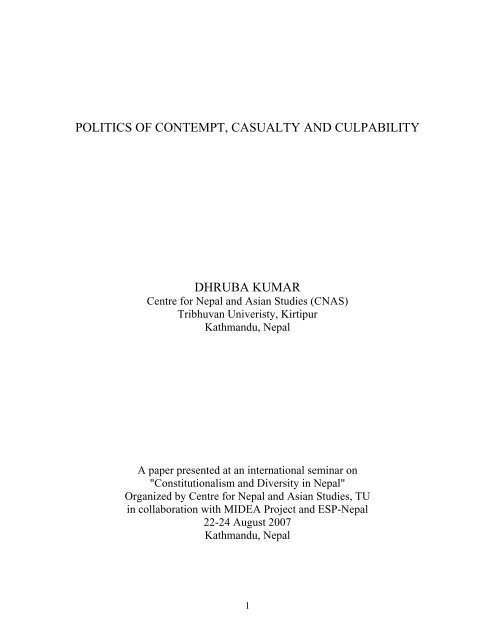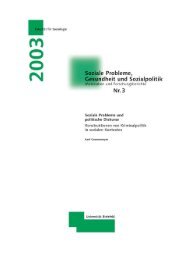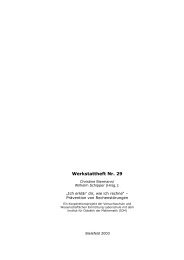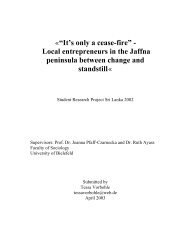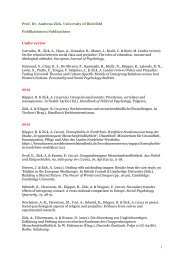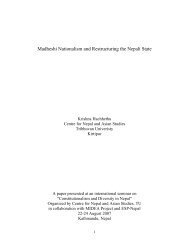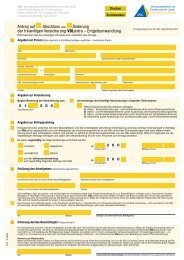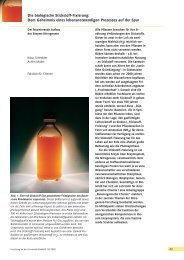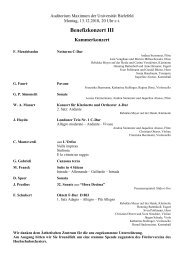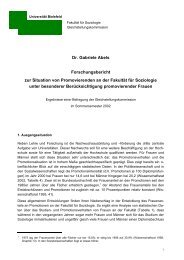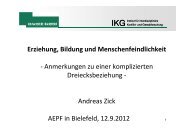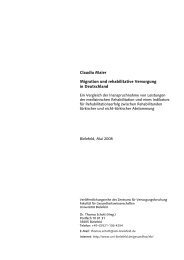POLITICS OF CONTEMPT, CASUALTY AND CULPABILITY ...
POLITICS OF CONTEMPT, CASUALTY AND CULPABILITY ...
POLITICS OF CONTEMPT, CASUALTY AND CULPABILITY ...
Create successful ePaper yourself
Turn your PDF publications into a flip-book with our unique Google optimized e-Paper software.
<strong>POLITICS</strong> <strong>OF</strong> <strong>CONTEMPT</strong>, <strong>CASUALTY</strong> <strong>AND</strong> <strong>CULPABILITY</strong><br />
DHRUBA KUMAR<br />
Centre for Nepal and Asian Studies (CNAS)<br />
Tribhuvan Univeristy, Kirtipur<br />
Kathmandu, Nepal<br />
A paper presented at an international seminar on<br />
"Constitutionalism and Diversity in Nepal"<br />
Organized by Centre for Nepal and Asian Studies, TU<br />
in collaboration with MIDEA Project and ESP-Nepal<br />
22-24 August 2007<br />
Kathmandu, Nepal<br />
1
Preliminary Draft<br />
<strong>POLITICS</strong> <strong>OF</strong> <strong>CONTEMPT</strong>, <strong>CASUALTY</strong> <strong>AND</strong> <strong>CULPABILITY</strong><br />
2<br />
Dhruba Kumar<br />
Some events occurring in the aftermath of the Jana Andolan II indicate about the brisk<br />
process of deconstruction of the organizational structure as well as operational code of<br />
the Nepali State. Tectonic shifts in the structural congruity of the State have been noted<br />
with the parliamentary decision of disrobing monarchical sovereignty in favour of<br />
popular sovereignty. The constitutive principles of the Nepali State composed of the<br />
erstwhile Kingdom ruled by the descendants of the first Shah King Prithivi Narayan<br />
Shah, Hinduism as a State religion, Nepali as the national language and the Army as the<br />
sturdy pillar supporting the monarchical State no longer remains valid. The myth built<br />
around monarchy as a symbol of national unity is demolished. The relevance of<br />
monarchy to the statecraft is fast eroding as the Interim Constitution 2007 has put<br />
monarchy into animated suspension.<br />
Though, the people have yet to demand to “cut off the king’s head” in Foucauldian way, 1<br />
the die has already been cast by the declaration of the parliament on 18 May 2006. 2 The<br />
king is no more reigning and ruling, secularism has become the virtue of the State, Nepali<br />
has become official language recognizing all other languages spoken in Nepal as national<br />
language, and the army is divested from monarchy to the parliament, in principle. The<br />
Interim Constitution has legally disbanded monarchy from all legitimate rights and roles<br />
in governance of the country (Article 159 [1]) snapping its political link with the State<br />
and society. The denial of the ritualistic observance of Bhoto Jatra to the king on 8 July<br />
2007 has also broken the traditional cultural tie of monarchy with the society. The<br />
cancellation of the public holiday to mark the birth anniversary of the first Shah King<br />
Prithivi Narayan Shah celebrated as the National Unity Day 3 through a public notice on 9<br />
January 2007 by the Ministry of Home Affairs thus ended the manufactured history of<br />
‘national unification’. 4<br />
Irrespective of these symbolic as well as significant moves taken towards deconstruction<br />
of history, one another piece of news report, as emanating, again from a government<br />
source, is worth considering at length in understanding the State in quandary. The news<br />
filed on 10 January says,<br />
The Nepali Congress-Democratic vice president and Minister for Physical Planning and Works [of the SPA<br />
government], Gopal Man Shrestha, said today [that] an agreement had been reached between the eight<br />
parties and the King to adopt a loktantrik [democratic] system with ceremonial kingship. He added that<br />
there will be a front of democracy and another front of supporters of republic in the CA polls.<br />
Speaking at a press meet, Shrestha said a “secret agreement” was made between the eight parties and the<br />
King on April 24, 2006 at a time when the Jana Andolan II was at its peak. He added that the Andolan<br />
ended after the agreement. “Maoist Chairperson Prachanda did not say anything about the King at that<br />
time. 5
No further arguments were made on this issue. Neither denial nor endorsement came<br />
forth from any quarter except from the occasional utterances of Prime Minister Girija P.<br />
Koirala to test the water by surfing on the wave of options for retaining monarchy even in<br />
the form of a ‘baby king’, vehemently opposed by the people from various walks of life.<br />
Apparently it seems that Koirala is babbling in confusion, and accused by some as a<br />
devout Royalist; his utterances, however, have the effects of generating and testing public<br />
opinion on monarchy more coherently than the results of any survey finding. 6 While<br />
tabling the Programme and Policies for the FY 2007-08 at the legislative-parliament on 4<br />
July, Prime Minister Koirala said that “The old remnants of feudalism must either<br />
disappear within the country or leave the country before the constituent assembly<br />
elections” indirectly hinting at the monarchy to abdicate the throne. He further said the<br />
youth of Nepal need not fight another battle for democracy. This should be the last<br />
battle.” 7 The practice of allocating annual budget for the King, the Royal Family and the<br />
Royal Palace under the heading number 11 is removed while presenting the budget by the<br />
finance minister, notwithstanding ‘sustenance budget’ is provisioned under different<br />
headings.<br />
The process towards deconstructing the monarchical state, thus, has formally begun. To<br />
cap this domestic process, the most influential regional and international actors have<br />
vouched their support by boycotting the invitation of King Gyanendra to attend his 61 st<br />
birthday party on 6 July. The decision of the representatives of the EU along with United<br />
States and India is both a step towards deconstructing as well as derecognizing the<br />
institution of monarchy in Nepal. 8<br />
Deconstructing History<br />
The first act of the SPA government led to a host of questions. Does this actually mean<br />
the end of the monarchical history by discrediting the state builder? Was that a significant<br />
decision to completely destroy the public authority enjoyed by the Shah rulers as the<br />
sovereign embodiment of the ‘popular will’? Has the military valour of Prithivi Narayan<br />
Shah, on the basis of which the Nepali State was built, been discredited? Has Prithivi<br />
Narayan Shah’s trek from the rugged hills of Gorkha to fertile Kathmandu Valley directly<br />
initiating the process of the formation of Nepali State become a sordid memory? Has the<br />
Nepali nationalism constructed around the sublime monarchical ethos become a farce?<br />
Has the decision of the Home Ministry really become a day of redemption for the people<br />
of Nepal from the bondage of the past? Are the people now freed from the ‘internal<br />
colonizer’ who founded the state on terror, emancipated?<br />
If the first act of the government has answered all the related questions in positive, the<br />
second act of the disclosure of the truth by a minister is negative with significant<br />
implications for the future architecture of the Nepali State. First, it suggests that the Jana<br />
Andolan II had also ended in a compromise arrived with the active participation of the<br />
Maoists by becoming one of the eight parties negotiating with the King. The second is the<br />
continuing deception of the political parties to the people and the betrayal of their trust.<br />
And the most ominous is the hypocrisy of the Maoists whose revolutionary élan had<br />
caused immeasurable loss of lives and properties along with making the State collapse,<br />
but for want of power.<br />
3
The Maoists are perhaps rejoicing with their success by “razing the city of God to the<br />
ground”, as long dreamed by Karl Marx, to overlord the Nepali State that would again be<br />
founded on terror. 9 It therefore leads me to recall what Albert Camus wrote 56 years ago:<br />
“All modern revolutions have ended in a reinforcement of the power of the state”. 10<br />
Marx’s interpretation of history, according to Camus, is that when it [men] is [are]<br />
“deprived of power, it [they] expresses itself [themselves] in revolutionary violence; at<br />
the height of its power, it risks becoming legal power, in other words, terror and trial”. 11<br />
Presently, the Maoists are bargaining for their best from within the government and by<br />
fielding unrestrained prowess of the Young Communist League (YCL) as ‘urban<br />
guerrillas’ in the streets. The Maoist ministers have even threatened to quit the<br />
government on the issue of change of guard to their security. 12 The Maoist Chairman<br />
claims that the army is more powerful than the prime minister. 13 The Maoist leaders have<br />
also complained that the country is run by India and the United States, not by the<br />
government of Nepal. Notwithstanding this, they have unashamedly stayed in the<br />
government enjoying state perks and privileges. The Maoist leaders have become<br />
infamous for their incredible public utterances. Though their credibility has dipped as<br />
their image has never been resonant, they are still indispensable forces in the transitional<br />
politics with anticipated cooperation on issues related to elusive peace and stability, albeit<br />
prevalent anarchy. The Maoists who had acted as counter-elites and optimized the<br />
prospect of change are also behaving in the way as the leaders of their partners in<br />
government. Hence the challenge that Nepal faces is holding leaders accountable for their<br />
deeds making the rule of law to prevail.<br />
Although the first act committed by the SPA government is a rupture in history, this<br />
process to come was already signaled and foreshadowed by disfiguring of the statue of<br />
Prithivi Narayan Shah during the Jana Andolan II demystifying the icon of the dynastic<br />
legitimacy of the Shah rulers. That was a sheer vandalism committed in an act of fury by<br />
the people, but the same act demonstrates the truth that the people have refused to coexist<br />
with the past. The decision that the SPA government had taken to bury the ‘glorious past’<br />
is therefore a continuity of a revolutionary situation fraught with violence in which the<br />
people are immerse with. Derrida views such a situation as ‘future anterior’. Accordingly,<br />
he opines, “All revolutionary situations, all revolutionary discourses, on the left or on the<br />
right justify the recourse to violence by alleging the founding, in progress or to come, of a<br />
new law. As this law to come will in return legitimate, retrospectively, the violence that<br />
may offend the sense of justice, its future anterior already justifies it.” 14 The destruction<br />
of the concept of self-immanence of the monarchical order central to the constitutive<br />
principles of the Nepali State is critical in the political repertoire of the renewal of the<br />
margins in the nation building enterprise.<br />
Dissecting with history is indeed a painful process, however. History is a fact of life. It is<br />
not only related to the genealogy of a community or a state, it is also a narrative of the<br />
community or a state on the basis of which the present is founded. Thus history is integral<br />
to the memory of a community with sentiments and symbols and with the construction of<br />
culture in identifying the self and the others. The present at creation has a historical past.<br />
It lives subconsciously in the memory of the people that guides their momentous<br />
4
ehaviour when occasion demands. Thus history is not a dead thing as some would like<br />
to make it. Historical records are facts of life. However, ‘the facts’ as Carr said, ‘do not<br />
speak for themselves’. 15 The interpretation and presentation of the facts, as in the case of<br />
Prithivi Narayan Shah’s digbijaya (victory) and ‘unification’ of scattered territories into<br />
a modern kingdom was simply a “Bir Gaatha”, as historian Pratyoush Onta would like<br />
to call it. This elitist mode of historiography, however, is not above controversies. 16<br />
But when history overlaps the political space resisting with tradition, custom and culture<br />
and collective memory of the people, it not only reflects in the ‘silent cry’ 17 but also in<br />
the grievous recollection of nightmares and genocidal violence as replicated, for instance,<br />
in the partition history of the Subcontinent. 18 Particularly in India, the partition history is<br />
reviving the popular consciousness than the ethos of the ancient Ram Janamabhumi<br />
instrumentalized as a political weapon by the Bharatiya Janata Party (BJP), and<br />
brutalized with fascist urge against the Muslim minority in Gujarat by Hindutva in 2002.<br />
Partition history, though horrendous, focuses on the people, the core of the silent mass<br />
that reconstructs the country despite their sufferings and losses. They also construct their<br />
belonging and awareness identity as refugees, settlers or indigenous people in relations to<br />
the State they live in. The experiences and livings of these toiling masses of the faceless<br />
people become the subaltern history, loosely used here to indicate the ethos of the<br />
common people.<br />
Likewise, the subaltern perspective of Nepali historiography is quite different from what<br />
the Maoists had supposedly posited. Although the ‘People’s War’ was waged with the<br />
rhetoric of fighting for the poor, destitute and marginalized, it led, unfortunately, to the<br />
marginalization of the already marginalized. 19 The Maoists also proved themselves<br />
wrong once they ascended to the State power and become authority by continuing the<br />
policy of exclusion. For example, both the Janajati and the Madhesi perspectives even on<br />
the narrative of current history of Nepal are different. 20 These groups of people feel that<br />
their identities have been devalued and excluded despite the political commitment made<br />
for ‘inclusive’ democracy. Hence the Janajatis are forced to negotiate with the<br />
government separately. And the Tharus, another group of indigenous people spread over<br />
western Tarai, are bent on preserving their separate identity from the Madhesi,<br />
particularly belonging to eastern Tarai. Their posture however remains non-violent.<br />
By contrast, the Madhesi alienation has turned violent. The centre-periphery conflict is<br />
now combined with cultural and territorial claims to greater autonomy or even secession<br />
from a larger ‘nation-state’. The widespread international phenomenon of deadly conflict<br />
thus has entered Nepal as the Madhesi ire has been swollen by the repressive design of<br />
the State. On the top of it, the Maoists have reciprocated to the Madhesi demands by<br />
vowing to crush them. Perhaps forgetting his own past, the Maoist Chairman Prachanda<br />
has opined that the media should not pay attention to the violent groups led by Jai<br />
Krishna Goit and Jwala Singh as they lack popular support. Although he supported the<br />
demands of the Madhesi movement, he has, nevertheless, also proposed for mobilizing<br />
armed forces and the Maoist guerrillas to quell the Madhesi violence. 21 Likewise,<br />
Baburam Bhattarai, another top Maoist leader has publicly chided these groups as<br />
“criminal elements,” who should not be negotiated with. Another Maoist leader C.P.<br />
5
Gajurel has also expressed his reservation against the government’s proposed talks with<br />
the Madhesi agitators suggesting “there is no point in holding talks with those who are<br />
separatist in nature.” He has reiterated the Maoist position that “the outfits which are<br />
fomenting crisis in Tarai be banned and crushed.” 22 Sadly, the Maoist leaders are<br />
currently borrowing the vocabularies of the previous governments which were at the<br />
loggerheads with them once they had initiated the violent “People’s War” in 1996.<br />
Challenge to Unitary State<br />
Tony Hagen has described Nepal as the ethnic turntable of Asia. The population of the<br />
country is thus naturally composed of diverse ethnic and caste groups. Data enumerated<br />
by the 2001 census record some 100 ethnic and caste groups, 92 spoken languages and 7<br />
religions predominated by Hinduism. However, a majority of people in Nepal are in<br />
minority category if the population census 2001 were to be considered as reflecting the<br />
ethnic mosaic. If Hill Brahmins (12.7 %) and Chhetris (15.8 %) constitute the majority,<br />
Kusunda, Patharkath/Kushwadia (0.0 % each) and eight other groups like Raute, Koche,<br />
Hayu etc. each comprise absolute minorities at 0.01 per cent of population. In between,<br />
there are Magar (7.1 %), Tharu (6.8 %), Tamang (5.6 %), Newar (5.6 %), Kami (4%),<br />
Yadav (4%), Muslims (4.3%), and Rai/Kiranti (2.8%) a majority of whom are in the<br />
disadvantaged category in the population structure of Nepal. 23 Besides the dominant<br />
groups comprising Brahmins and Chhetris along with Newars the rest of the people<br />
identify themselves either as national minorities or indigenous people dominated and<br />
discriminated against in every socio-political and public spheres. This awareness has led<br />
to conscious assertion of minority rights politicising the issues of social inclusion for<br />
broadening the base of participation in the public sphere. The process of homogenization<br />
of the social sphere has been resisted despite the hegemonic control maintained by the<br />
State. Yet the issue is far from being explosive and violent.<br />
As the country is divided into three prominent ecological zones with mountains, hills and<br />
plains, the people inhabiting these topographical regions are distinct in their features, food<br />
and cultural habits. When multiculturalism has been a recognized fact of life, Nepal is<br />
also a country with religious assortments, although Hindus are definitely in majority.<br />
Among the Hindus, the high caste hill Hindu elites have adopted “monopolistic policy”<br />
leading to marginalization of three main social groups on the basis of culture (the<br />
janajatis), on the basis of caste (the Dalits), and on the basis of geography (the Madhesi). 24<br />
Diversity, dominance and hegemony are the common features in the ethnopolitical<br />
discourses as 59 Janajati groups constituting some 37 per cent of the population are<br />
groping for their identity and representation in the socio-political milieu dominated<br />
mostly by the Bahun-Chhetri combine ranging from political parties to newspaper<br />
vendors. All the major political parties are led by Brahmin/Chhetri caste people. The<br />
cases of representation in the Central Committee of political parties, including the CPN<br />
(Maoist) also evince this pattern of Brahminic domination. Available data as of June 2007<br />
show Brahmin comprises 51.4 per cent in the Central Committee of the Nepali Congress<br />
party (NC), 38. 9 per cent in the Nepali Congress (D), 58.5 per cent in the CPN (UML)<br />
and 45.7 per cent in the Central Committee of the CPN (Maoist). Likewise, the<br />
representation of Chhetris is 18.9 per cent in the NC, 30.6 per cent in NC (D), 15.4 per<br />
6
cent in CPN (UML) and 25.7 per cent in the CPN (Maoist). Similarly, the ‘legislativeparliament’<br />
presently is composed of 33 per cent of Brahmins and 18 per cent of<br />
Chhetri/Thakuri combine making a total of 51 per cent. Altogether these two caste groups<br />
combine constitutes 30 per cent of the total population in accordance with the 2001<br />
national census records. They, however, comprise 66.2 per cent of governing elites in the<br />
state structure. 25<br />
If one were to take the interests of the political parties as influential in decision making of<br />
the parliament and the government predominated by Bahun-Chhetri caste groups, it is<br />
preordained to surmise that their interests would prevail both in rule making and rule<br />
enforcing processes. Obviously, political power would simply ensure a sequence of<br />
inequalities in the society in spite of bewildering diversities. Dominance and<br />
subordination interacts to nourish the power to stabilize the core of the relationships in<br />
which coercion and persuasion, and collaboration and resistance will form the general<br />
configuration of power of the State sustained by unequal relationships. Govinda Neupane<br />
thus has raised the question of fair representation and social justice in his seminal study<br />
on ethnicity and prevalent inequality in Nepal. 26<br />
Nepal that has thrived mostly on the excessive centralization of power as a unitary state is<br />
increasingly being challenged by groups of disaffected people; peacefully by some and<br />
violently by some others. The Janajati groups though having warned about the<br />
unfortunate consequences of the state discrimination; are yet to go violent,<br />
notwithstanding the Khambuwan National Front, Limbuwan Liberation Front, Mongol<br />
National Organization, Tharuwan and Newa groups are all clamouring for autonomy and<br />
political power. Despite some like Khambuwan National Front was bent on violence and<br />
the Mongol Liberation Army was fielded by the Mongol National Organization, most of<br />
them want to resolve the contending issues against exclusion and discrimination<br />
peacefully through negotiations.<br />
On the other hand, some others, as militant groups, took violence as a means to resolve<br />
the problems they face. The Janatantrik Tarai Mukti Morcha (JTMM) led by Jwala Singh<br />
celebrated violence in the Tarai demanding regional autonomy with the killing of a<br />
popular member of the parliament months before the beginning of the Madhesi Andolan. 27<br />
Numerous violent groups presently configuring in the Tarai have learned lessons from the<br />
Maoist violence leading to the latter’s success of power sharing in the central government.<br />
As a matter of fact, all the prominent groups at the forefront of the Tarai movement are<br />
led by the people breaking out from the Maoist group. The Madhesi Jana Adhikar Forum<br />
(MJF), the JTMM-Goit and the JTMM-Jwala Singh were all the part and parcel of the<br />
Maoist insurgency.<br />
The Maoists who had cultivated diverse ethnic groups during the course of insurgency<br />
mobilization had formed nine autonomous regions on ethnic lines with a commitment to<br />
rights to self-determination and secession. 28 They have, as well, promised to resolve<br />
ethnic problems within the framework of national autonomy in their much publicised 75point<br />
programme. 29 The prominence given to ethnic grievances as a strategy to encourage<br />
ethnic militancy has certainly help expand the Maoist insurgency. This policy of<br />
7
appeasement, however, is now rebounding. Ironically, the Maoists are inculcating a threat<br />
to Nepali nationalism through Madhesi movement. Hence there is a truism in the Madhesi<br />
accusation of the Maoists carrying the bogey of Pahadia nationalism narrowly concepted<br />
and confined to promoting parbatia interests.<br />
The Maoist insurgency has, no doubt, set a dangerous precedent in radicalizing as well as<br />
inspiring some people to step into their shoes. 30 The objective of such violent activities and<br />
fomenting terror is setting the target by attracting attention to the obscure group. The<br />
meaning of terror, as Charles Tilly has noted is the “demand for recognition, redress,<br />
autonomy or transfer of power.” 31 Tarai as a geographical region and Madhesi as the<br />
citizens of the country have long been ignored and mistreated by the central political elites<br />
except for retaining territorial claims and amass economic returns from the region.<br />
Despite the region being the granary of Nepal, Tarai is never articulated as a social and<br />
cultural space reflecting the Nepali nationhood. Tarai remains a place to command,<br />
control and consolidate the hill dominance through migration and settlement of the hill<br />
people, expansion of administrative and coercive power and authority by co-opting some<br />
greedy Taraians in the power centre. Tarai remains a land frontier zone, open and<br />
vulnerable to penetration and, defenceless. And amongst slightly over 32 per cent of total<br />
population categorised as Madhesi, it was claimed that some 4 million are denied<br />
citizenship till recently. This denial of the entitlement to its own people by the State is the<br />
denial of the human rights.<br />
The denial of citizenship right is fundamental to the policy of social exclusion. 32 Social<br />
exclusion comprehends a situation deliberately fostered by the state as a process “through<br />
which individuals or groups are wholly or partially excluded from full participation in the<br />
society in which they live.” Thus, social exclusion is structural in nature where the state is<br />
not neutral. In other words, it is a “soft violence” that the state pursues to deny certain<br />
bracket of its citizenry (i) the access to social services such as health and education; (ii)<br />
access to labour market except from low paying discarded jobs; and (iii) the opportunities<br />
from social and political participation. Social exclusion substantially involves the political<br />
dimension in which the state discriminates between insiders and outsiders and may<br />
exclude some social groups and include others to preserve the interests of dominant class<br />
in a society. 33 Social exclusion is, thus, a pointer to a distinction between afno and auruko<br />
manchhes. 34<br />
Denial of citizenship is also the denial of belongingness. The Madhesi people have<br />
ultimately found that their identity of belongingness to the State has not changed even<br />
after the political change. Belongingness that brings entitlement was long denied as a<br />
majority of Madhesi remains stateless. This awareness identity therefore becomes crucial<br />
to the Madhesi people to pursue for their rightful place in the socio-economic and political<br />
mainstream of the State. Thus, the element of subalternity involved in the Madhesi<br />
movement cannot be ignored as it reflects the age-old discrimination against the people<br />
who have been used only for the benefits of their own compatriot Pahadia political<br />
masters. The unitary state with its centralizing authority has expressed overwhelming<br />
tendency for dominance with coercion rather than governance with persuasion. Such a<br />
behavioural pattern of the State, in sum, is a total negation of their identity and existence.<br />
8
The awareness identity of continuous discrimination has thus forced the conscience of the<br />
Madhesi people (as well as other Janajati groups) to distinguish between the traditionally<br />
laid aristocratic sovereignty and popular sovereignty, as the later being the case for the<br />
Nepali peoples’ uprising against the monarchical regime. The opening paragraph of the<br />
Preamble of the Interim Constitution 2007 says, “We, the sovereign… Nepali people,”<br />
that fundamentally ensures the popular sovereignty guaranteeing equality, individual<br />
rights, ownership to private property, development and national consensus. These<br />
elements of human dignity represent the powerful forces of liberation and emancipation,<br />
as David Nugent asserts. 35 Irrespective of the constitutional dispensation, when the<br />
awareness of challenge to human dignity increases with persistent racial, cultural,<br />
linguistic and geographical distinction the situation at the margins as the sites of<br />
exclusion, domination and difference could turn to be explosive. The Madhesi uprising is<br />
therefore a case for deconstruction of the unitary state as their demands for federalism as<br />
the state structure and proportional representation as the electoral process coupled with<br />
allocation of constituencies according to the population size are striving for destroying the<br />
core of centralized polity with exclusive hill dominance in the country. The Madhesi<br />
movement is writing a new chapter in the Nepali history that crucially focuses on the<br />
people long treated as aliens. Their agitation compelled the government to amend the<br />
Interim Constitution on 9 March 2007 ensuring the establishment of a federal state<br />
structure through elections to constituent assembly. Therefore their rights to entitlement<br />
cannot be denied.<br />
Liberalism, as the multiparty democratic system is inclined to pursue, remains inadequate<br />
in fostering inclusive policies as the Madhesi as a social category reflects multiplicity of<br />
caste groups with majority-minority and touchable-untouchable syndrome. Hence a single<br />
template for accommodating variegated Madhesi grievances is not appropriate. The<br />
options of quota and reservation are still a puzzle. Critical chasm loaded with castism<br />
between different group remains which is difficult to eliminate only with legal measures.<br />
The caste structure of Madhesi Hindus reflecting 20 groups in the Vaisya category alone<br />
is noted as more complex and diverse and culturally too the Madhesi are most<br />
heterogeneous. As 30 per cent of hill migrants inhabit the Tarai, the process of making it<br />
ethnically autonomous will also be complicated. 36 Madhesi therefore is not an ethnic<br />
compact and united group. The high caste Madhesi like the Rajput, Jha Brahmins pitted<br />
against the Yadavs are as old stories as their settlement. Though resentment against<br />
perceived injustice and discrimination is a uniting factor, tensions steaming from regional<br />
differences and stricter caste systems are spreading below the surface. However, ethnic<br />
diversity leading to discrimination related to identity creates a condition for conflict and<br />
violence. The perception of a dominant minority treating a numerical majority but<br />
ethnically a fragmented group as the others makes the situation more complicated in the<br />
absence of any converging interests between the contending groups.<br />
Aspiration and Aspersion<br />
From one perspective, the Madhesi aspiration is simply confined to the power-sharing.<br />
Their demands, as pointed out by Ram Prakash Yadav, are,<br />
9
1. A liberal policy of citizenship so that most of the citizenshipless people can get<br />
their identity and fully participate in building this nation as bona fide citizens.<br />
2. Official status for Hindi language as the ‘lingua franca’ that binds all Madhesi<br />
together.<br />
3. Employment quota for Madhesi in civil service and army, thereby bringing them<br />
in the mainstream of national development.<br />
4. A federal system of government to recognize their separate identity. 37<br />
Within the framework of making Nepal a federal state through elections to the constituent<br />
assembly, the Madhesi have raise their rightful demands for proper representation through<br />
peaceful movement caused by the political centre’s treatment of Tarai yet as the<br />
backwater of the national polity after Jana Andolan II. The sheer neglect and indifference<br />
amongst the leaderships at the centre towards the simmering problems of Madhesi people,<br />
continued discrimination as well as state repression bordering on the communal measures<br />
(as evident in the Nepalgunj riots in December 2006) has made the situation most<br />
depressing and desparate. 38 The peaceful protests over the promulgation of the Interim<br />
Constitution on 15 January 2007 staged by MJF turned into heinous ethnopolitical<br />
violence after it was allegedly provoked by the Maoists in Lahan. Meanwhile, the<br />
“excessive use of force” by the government had resulted into the killings of 37 people in<br />
January-February 2007 during the Madhesi uprising. 39 Again, the government’s<br />
indifference has led to the Gaur massacre caused by the violent contention between the<br />
Maoist and the MJF forces on 21 March 2007. The carnage and misfortune could have<br />
been easily avoided had the Maoists controlled their inflated ego. 40 The tensions brewing<br />
between the Maoists and different Madhesi groups on the one hand, and the government’s<br />
provocative measures, 41 on the other, is gradually converting the situation in the Tarai into<br />
communal as well as sectarian conflicts.<br />
Consequently, the threshold of threats of ethnic cleansing is rising. Ever since the JTMM<br />
led by Jwala Singh has posted a circular to the government officials of the hill-origins<br />
(Pahade) to vacate the Tarai on 14 April 2007, most of the government institutions are<br />
reportedly functioning without the head and other pahade officials. Many of them have<br />
left their post and returned home as insecurity increased and the threat and fear of ethnic<br />
turmoil rise. The governmental lethargy and inability to manage the challenges emanating<br />
from the Tarai has encouraged several criminal elements. The eventual emergence of<br />
some obscure but violent Madhesi organizations like the seemingly ferocious Tarai<br />
Tigers, Tarai Cobra, and Tarai Army as well as Tarai Rebel groups have further increased<br />
insecurity among the hill people living in the Nepal Tarai. Another militant group led by<br />
Visfot Singh – a breakaway faction of the JTMM (Goit) – has emerged with secessionism<br />
as its policy plank. Ironic indeed is the situation when the Prime/Defence, Home<br />
Ministers belonging to the NC and the General-Secretary of the CPN (UML), though hill<br />
Brahmins, are the representatives of the Tarai constituencies. They have shown scant<br />
interests in pacifying the acts of fomenting violence in their own district constituencies.<br />
However, they can no more turn their blind eyes towards this systemic challenge when<br />
they are tasked to hold elections to constituent assembly.<br />
10
The Madhesi uprising sensitizing the problems of inclusion has, therefore, forced the State<br />
to turn its attention towards the issue when the entire Nepali people, perhaps with some<br />
exception, morally allied with the justifiable Madhesi demands and supported their cause.<br />
The unspoken alliance between Janajatis and Madhesis is crucially cushioned by women<br />
and Dalits in critiquing the current posture of the Nepali State forcing it to open up the<br />
avenues of equitable participation of the marginalized groups. Such a popular force has<br />
crumbled the structure of the unitary state aspired to be replaced by the features of federal<br />
structure. Federalism is the common plank in which the Janajati and Madhesi groups are<br />
in unison as they are not going to settle for less than this. Hence the Madhesi movement in<br />
its present form can be understood as an extension of the Jana Andolan-II launched with a<br />
clear mandate of turning Nepal into a republican State.<br />
The government, including the Maoist had downplayed the Madhesi movement as<br />
inconsequential. They have blamed it as prompted by pro-palace conspirators conniving<br />
with the Hindu fundamentalists and communal elements. However, they are now forced to<br />
rethink over the entire issue as the violence has continued unabated, the satisfactory<br />
resolution of which could only be a safe passage to socio-economic and political stability<br />
and national integrity. Elections to constituent assembly now dangle on the resolution of<br />
the Madhesi problem.<br />
Although the centre-Tarai relationships have always been conflictual and dissension has<br />
continued to influence opinion since long, the combined cultural and territorial claims to<br />
greater autonomy from a larger nation-state has quite recent origin notwithstanding the<br />
rhetoric “Sri Lanka bana denge” was shouted from the roof top by the Sadbhavana party<br />
since 1980s. The list of societies experiencing such conflict in the world is long. Even the<br />
‘United’ Kingdom has trouble in its backyard called Northern Ireland, and the 7/7 (2005)<br />
is the evidence of quite a negative posturing present in the British society despite of<br />
multiculturalism. However, the conflict’s model for Nepal remains Sri Lanka, not<br />
resembling as Tamil versus Sinhalese problem but alike that between the government and<br />
the JVP in 1971 and later 1987 – Sinhalese against Sinhalese – irrespective of being the<br />
government against the Sri Lankan Maoists. The Pahadia-Madhesi clashes can be<br />
contemplated on the basis of hill versus madhesi nationalism. But that will not be<br />
sermonized by their common Hindu religion. Although it is said that ethnic animosity is<br />
not entrenched, the political goal of madhesi nationalism could be ethnic cleansing as<br />
indicated by the exodus of Pahadia civil servants from Tarai. The forced abandonment of<br />
their posts by the government officials is the fresh testimony to quashing of the pahadia<br />
hegemony and domination in the everyday life of the madhesis. The Madhesi movement<br />
can invent a particular set of history to inform the disgruntled mass and use it for political<br />
mobilization. For instance, take the case of a propaganda material cited below published<br />
to misinform the public and incite violence.<br />
“ ‘Madhesis are Indians. They should never be appointed to the civil service posts higher<br />
than Kharidar and Mukhiya.’” This statement is attributed to King Prithvi Narayan Shah<br />
as his ‘upadesh’ by a Madhesi activist Bijaya Karna in the opening sentence of his latest<br />
article. 42 No source is cited from which he has quoted the statement. But this sentence is<br />
not traceable in Prithvi Narayan Shah’s Dibya Upadesh. Karna is deliberate in infusing a<br />
sense of militancy amongst those disgruntled elements who had already sharpened their<br />
11
criticism and contention against monarchy without contemplating the likely effects of this<br />
intentionally distorted ‘historical fact’ and churning of disinformation fanning the flame<br />
of dissension. Although nobody will dispute the fact that Madhesi are still looked at with<br />
a jaundiced eye by the Pahadia political elites, 43 it does not, however, justify the acts of<br />
producing ‘manufactured truth’ by telling white lies in support of Madhesi Andolan that<br />
actually needs no justification. Perhaps this propaganda can reap a good harvest for the<br />
author who also runs a NGO, but not for his compatriot Madhesi citizens and the country<br />
as a whole.<br />
Ethnic conflict has a peculiar mind-boggling pattern witnessed around the world when<br />
neighbours turn bloodthirsty demons. According to Anthony Smith, the politics of<br />
ethnonationalism everywhere has been fuelled by the triple process of the purification of<br />
culture, universalization of closeness and territorialization of memory. 44 Smith has<br />
sensibly defined the concept of nation as a named human community occupying a<br />
homeland and having common myths and a shared history, a common public culture, a<br />
single economy and a common rights and duties for all members which shapes the<br />
concept of ethnie as “a named human community connected to a homeland, possessing<br />
common myths of ancestry, shared memories, one or a more elements of shared culture<br />
and a measure of solidarity, at least among elites.” 45<br />
With its distinct physical feature and human geography the Tarai presents a segregated<br />
identity where more than 93 per cent of Madhesi population lives. This feature has<br />
tempted some violent groups to opt for secession that Goit stood for asserting that Tarai<br />
was never a part of Nepal. 46 Hence the process of deconstruction of the Nepali State is at<br />
its height as the groups led by Goit and Jwala Singh factions of the JTMM have<br />
demonstrated their secessionist urge rather than the insurgents of the Maoists type who<br />
had fought closely to seize state power. The armed rebellion groups in the Tarai are<br />
preparing for a showdown with the State not to over run its capital city but to dissuade the<br />
State from fighting in the territory they are trying to liberate by asserting their separate<br />
identity. The nature of the Madhesi movement, therefore, is quite different from the<br />
Maoist insurgency. The objective of its armed groups like JTMM-Goit is liberation to<br />
achieve freedom, not simply an end to “semi-feudal state”.<br />
The disclosure of Ram Raja Prasad Singh, the mavarik Madhesi leader, who was<br />
requested to lead the separatist movement of the Tarai by the Madhesi agitational<br />
leaderships, thus, is a powerful expression of a burgeoning situation far from being<br />
conducive to peace and amity. 47 This is another perspective with growing acceptability<br />
amongst the Madhesi youths. The temptation towards secessionism could further grow<br />
with the State’s negligent and delaying tactics. Killings have continued intermittently<br />
despite the threats of reprisals by the Chief of Army Staff subsequently endorsed by Prime<br />
Minister Koirala the next day while visiting the Army Headquarters. 48 Demands for the<br />
“self-rule” but not secession, and “cry freedom” as well, are the high pitch slogans raised<br />
by both Madhesi Janadhikar Forum (MJF) and Janatantrik Tarai Mukti Morcha (JTMM-<br />
Goit), two front running groups in the Madhesi movement.<br />
12
The movement however has forked to two different directions. Whereas the MJF has<br />
prioritize negotiations as the best way to settle its scores with the centralized State, the<br />
JTMM –Goit and Jwala Singh are against any semblance of negotiated settlement. 49 In its<br />
third round of negotiations with the State concluded on 28 July, the MJF has proposed to<br />
dissolve the ‘interim parliament’ with the announcement of the programme for the<br />
elections to the constituent assembly. It has demanded to relinquish the constituency<br />
delimitation committee’s report and make the proportional representation system for the<br />
fair representation of all types of people. The leader of the MJF Upendra Yadav has also<br />
proposed to restructure the existing Election Commission with the representatives from<br />
the marginalized groups and reconstitute the government to make it inclusive for holding<br />
impartial elections. 50 The MJF however is not optimistic about any positive response from<br />
the government on these issues as the commitment made by the government during the<br />
first round of negotiation in Janakpur remains unimplemented. However, the MJF has no<br />
alternative than to wait for the cabinet decision 51 before making another move.<br />
The failure of negotiation perhaps would be more costly; it would justify the position of<br />
the violent Madhesi groups and fuel their energies to continue disruptive activities<br />
inviting the State reprisals, thus fulfilling their objective of destroying the possibility of<br />
holding the constituent assembly elections in November with continuing chaos and<br />
anarchy. If the negotiations for self-rule or autonomy fail, the sound bytes of cry freedom<br />
could increase.<br />
Some Observations<br />
As the situation stands presently, the Madhesi movement cannot be peripherialized<br />
anymore by the central authority. It has already cast a shadow over the future architecture<br />
of the Nepali State. The reality is that the dynamics of movement has undermined the<br />
political sway of the Nepali Congress Party from its Tarai vote bank. The Maoists, as<br />
well, are totally routed after the Gaur massacre. The destruction and demolition of the<br />
statues of pahadia leaders in the Tarai are a reflection of Madhesi ire. This is also an<br />
indication of the moderates loosing ground rapidly to the emerging violent groups. The<br />
looming fear is that the colour of violence would be ethnic rather than ‘class’ as depicted<br />
by the Maoists during the ‘People’s War’. Ethnic violence could be genocidal as<br />
witnessed in numerous other countries. The question however is that are the Nepali<br />
leaders claiming to be true representatives of the people waiting for such inhumanity to<br />
occur before making any sensible decision to address the critical ethnic challenge.<br />
Perhaps the deconstruction of history is an imperative for a state in making that has<br />
vowed to be inclusive with a constitution made by the people through the elections to the<br />
constituent assembly. The denial of this right to the people under any pretext would, thus,<br />
be depriving them of their much coveted role of exercising their sovereign rights. In such<br />
a context it would not be the monarchy but the political parties themselves, which would<br />
be the real and critical impediment for institutionalizing democracy fundamentally based<br />
on the popular will as mandated by Jana Andolan II. Elections to constituent assembly are<br />
essential in legitimizing the political process developed after the success of Jana Addolan<br />
II and the decisions made afterwards. Otherwise, the political process itself would be<br />
illegitimate as it was initiated with the restoration of the legitimately dissolved parliament<br />
13
under the erstwhile1990 Constitution by a political decision of the king on 24 April 2006.<br />
Recall the ‘secret agreement’ as pointed out earlier that ended the Jana Andolan.<br />
Deconstruction, though, has initiated a change, however, without recognizing the<br />
fundamental challenges facing the citizenry and grievances they have put across the<br />
political board for due consideration. The ethnic challenges posed through raising<br />
demands for provinces, regional autonomy, or even self-determination are the cases of<br />
further democratization of the State providing a vibrant political constituency not only for<br />
discourses and debates but also for broadening participation of general mass in<br />
restructuring the Nepali State.<br />
Notes<br />
1. Michel Foucault, The Foucault Reader, New York: Pantheon Books, 1984: 63-65.<br />
2. “The Declaration of the House of Representatives – 2063 (2006) made by Prime Minister<br />
Girija P. Koirala on 18 May 2006”, Kathmandu: Parliamentary Secretariat, Singha<br />
Darbar.<br />
3. The Himalayan Times, 10 January 2007.<br />
4. While launching his second coup on 1 February 2005, King Gyanendra has asserted in his<br />
address to the nation that “The Kingdom of Nepal was built on the foundation of the<br />
unification process initiated by King Prithvi Narayan Shah the Great.” See Gorkhapatra,<br />
2 February 2005. This implies his inherent rights to rule the country directly.<br />
5. See “CA polls to witness two fronts, says minister Shrestha,” The Himalayan Times, 11<br />
January 2007.<br />
6. For example, one public opinion survey has found 58.7 per cent of people responding to<br />
abolishing monarchy compared with 41.3 per cent assenting to retaining monarchy. See<br />
“State of Democracy in Nepal, Findings of Second Round Survey 2007: Top line<br />
Findings,” (Nepal Chapter, South Asian Democracy Study Group in Collaboration with<br />
International IDEA, Released on 7 June 2007). Another opinion poll report has also<br />
indicated about the falling popularity of monarchy. See Sudhindra Sharma and Pawan<br />
Kumar Sen, Nepal: Contemporary Political Situation – IV: Opinion Poll Report,<br />
Lalitpur: Interdisciplinary Analysts, April 2007. But the popular response to the proposed<br />
agenda of ‘baby king’ is totally negative as people have become more suspicious of this<br />
being an obstacle to the constituent assembly elections. See, Tilak Pathak, “Nati Raja,”<br />
Nepal Weekly, 1 July 2007: 22-26.<br />
7. See, Gorkhapatra, 5 July 2007; Kantipur Daily, 5 July 2007.<br />
8. See, “Envoys to king: Thanks, but no thanks,” The Himalayan Times, 5 July 2007;<br />
“Rajdootharu Darbarko nimtoma na jane,” Kantipur Daily, 5 July 2007.<br />
9. Albert Camus, The Rebel (translated by Anthony Bower), Harmondsworth, Middlesex:<br />
Penguin Books, 1967: 146.<br />
10. Camus, The Rebel, 146.<br />
11. Camus, The Rebel, 207-208.<br />
12. “Maoists threatens to quit govt.,” Kathmandu Post, 24 July 2007.<br />
13. See “Army HQ mightier than PM: Prachanda,” The Himalayan Times, 29 July 2007.<br />
14. Jacques Derrida, “Force of Law: The Mystical Foundation of Authority,” in Drucilla Cornell,<br />
et al., eds., Deconstruction and the Possibility of Justice, London: Routledge, 1992: 35.<br />
15. E. H. Carr, What is History?, Harmondsworth, Middlesex: Penguin Books, 1962: 5.<br />
16. See Krishna Kant Adhikari, A Brief Survey of Nepali Historiography, Kathmandu: Buku,<br />
1980; and, Baburam Acharya, Aba Yesto Kahilye Nahos, (Never Again), Kathmandu:<br />
Srikrishna Acharya, 2056BS.<br />
14
17. Ludwig F. Stiller, The Silent Cry: The People of Nepal, 1816-39, Kathmandu: Sahayogi<br />
Prakashan, 1976.<br />
18. Serious research interest on partition history is increasing not only in India particularly<br />
covering the western front but also in Bangladesh covering the east which was neglected<br />
till recently. For some representative samples, see, Ritu Menon and Kamala Bhasin,<br />
Borders and Boundaries: Women in India’s Partition, New Delhi: Kali for Women,<br />
1998; Imtiaz Ahmed, ed., Memories of Genocidal Partition: The Haunting Tales of<br />
Victims, Witnesses and Perpetrators, Colombo: RCSS, 2002; and, Meenakshie Verma,<br />
Aftermath: An Oral History of Violence, New Delhi: Penguin Books, 2004.<br />
19. For details see, Dhruba Kumar, “Terrorism and Subalternity – II: The Marginalization<br />
Syndrome in Nepal,” in Imtiaz Ahmed, ed., Understanding Terrorism in South Asia:<br />
Beyond Statist Discourse, New Delhi: Manohar Publishers, 2006: 287-344.<br />
20. For example, see, Parsuram Tamang, Janajati Ra Rastravad, (Ethnicity and Nationalism),<br />
Kathmandu: Jana Sahityik Prakashan Kendra, 1997; Durgahang Yakha-Rai, Brahmanbad<br />
Biruddha Janajati+ Utpiditbarga, (Brahminism versus Nationalities+Oppressed Class<br />
People), Kathmandu: Dhanrani Yakha Rai, 1996; Gopal Gurung, Hidden Facts in<br />
Nepalese Politics, Kathmandu: Gopal Gurung, 1994; Sita Ram Tamang, Nepalma Jana-<br />
Jati Samasya, (The Question of Ethnicity in Nepal), Kathmandu: P. Tamang, 1987;<br />
Harprasad Chattopadhyaya, Migration Between India and Nepal: A Socio-cultural Study,<br />
Calcutta:Firma KLM Private Limited, 1996: 70; Hari Bansh Jha, The Tarai Community<br />
and National Integration in Nepal, Lalitpur: Centre for Economic and Technical<br />
Studies/FES, 1994; and, Frederick Gaige, Regionalism and National Unity in Nepal,<br />
Berkeley, CA: University of California Press, 1975.<br />
21. See “Prachanda backs Madhesi cause,” The Himalayan Times, 2 February 2007. Prachanda<br />
has however denied that he had ever suggested for mobilizing the national army and the<br />
Maoist guerrillas against the Madhesi movement. Clarifying the confusion, Prachanda<br />
said that he has talked about the mobilization of the Nepali Army and the People’s<br />
Liberation Army together – as it should be understood that the state has two armies – in<br />
case the reactionary forces would try to conspire against the people’s achievements of the<br />
19-days long Jana Andolan and the People’s War, both at the Eight-Party meeting as well<br />
as at the Press Conference. But the context has been distorted. See the Interview given by<br />
Prachanda, Chairman, CPN (Maoist) and Supreme Commander, People’s Liberation<br />
Army, Nepal, to Janadesh Weekly, 13 February 2007. Despite his denials, Prachanda has<br />
favoured stringent police measures to be taken against the Madhesis. See “Aba Ekaisaun<br />
Shatabdiko Naulo Janabidroha Hunechha,” Janadesh Weekly, 20 March 2007.<br />
22. For Gajurel’s speech see, “Maoists reject talks offer,” The Himalayan Times, 15 July 2007.<br />
23. Central Bureau of Statistics, Population Census 2001: National Report, Kathmandu: HMG/N<br />
National Planning Commission Secretariat, 2002; Dilli Ram Dahal, “Social Composition<br />
of the Population: Caste/Ethnicity and Religion in Nepal,” in Central Bureau of Statistics,<br />
Population Monograph of Nepal, Vol.1, Kathmandu: HMG/N National Planning<br />
Commission Secretariat, 2003.<br />
24. Harka Gurung, “Trident and Thunderbolt: Cultural Dynamics in Nepalese Politics,” (The<br />
Mahesh Chandra Regmi Lecture 2003), Lalitpur: Social Science Baha, 2003:11.<br />
25. Govinda Neupane, Nepalko Jatiya Prashna: Samajik Banot ra Sajhedariko Sambhawana,<br />
Kathmandu: Centre for Development Studies, 2000: 82.<br />
26. Neupane, Nepalko Jatiya Prashna, 2000.<br />
27. For an over view see, ICG, Nepal’s Troubled Tarai Region, Asia Report No.136, Kathmandu:<br />
International Crisis Group, 9 July 2007.<br />
28. See Mahima Weekly, 14 February 1998. Also see, Sudheer Sharma, “Ethnic Dimension of the<br />
Maoist Insurgency,” (A report submitted to DfID, Kathmandu, May 2002).<br />
15
29. See, URPC, “Programme of United Revolutionary People’s Council Nepal,” (A resolution<br />
adopted at the formation of the 37-member United Revolutionary People’s Council with<br />
Baburam Bhattarai as convener, November 2001).<br />
30. See “Donation demands terrify traders in Inaruwa, Itahari,” The Himalayan Times, 29 July<br />
2007. The JTMM-Goit and Madhesi Tigers are in extortion spree in these districts in the<br />
name of donations from business persons in particular. They have warned that “those<br />
failing to pay the amount demanded will be killed.”<br />
31. Charles Tilly, “Terror, Terrorism, Terrorists,” Sociological Theory, 22(1), March 2004: 9.<br />
32. Since January 2007 the government has distributed a total of 2,571,998 citizenship certificates<br />
of which 121,086 certificates are distributed in the Sarlahi district in the Tarai and 123 in<br />
mountainous district of Manang. This is done in view of the forthcoming elections to the<br />
constituent assembly. See Kantipur Daily, 12 May 2007.<br />
33. Ajit Bhalla and Frederic Lapeyre, “Social Exclusion: Towards and Analytical and Operational<br />
Framework,” Development and Change, July 1997.<br />
34. Dor Bahadur Bista, Fatalism and Development: Nepal’s Struggle for Modernization,<br />
Hyderabad: Orient Longman, 1991.<br />
35. David Nugent, “Modernity at the Edge of Empire,” in Joan Vincent, ed., The Anthropology of<br />
Politics: A Reader in Ethnography, Theory, and Critique, London: Blackwell Publishers,<br />
2002: 313.<br />
36. Dilli Ram Dahal, “Making the New Nepal: The Socio-cultural Bases and Limits of Federalism<br />
in Modern Nepal,” (A paper presented at a seminar on “State Restructuring and<br />
Transformation” organized by Nepal Peace Campaign, an NGO, on 20 March 2007 in<br />
Pokhara):12.<br />
37. Ram Prakash Yadav, “Madhesi: A Disadvantaged Social Group,” The Organization, April-<br />
June 2006: XI-XVI.<br />
38. See CK Lal, “Nairashyatako Bhungroma Medhes,”Himal Khabarpatrika, 30 January-12<br />
February 2007: 40-41; Brishesh Chandra Lal, “Madhesi Aakroshka Sutradharharu,” Nepal<br />
Weekly, 4 February 2007: 28-29.<br />
39. See, Sarad KC, “Adhikarko Khoji,” (Rights’ Demand), Himal Khabarpatrika, 30 January-<br />
12 February 2007: 30-34; Tilak Pathak et al, “Asanthust Madhes,” (Disgruntled Madhes),<br />
Nepal Weekly, 4 February 2007: 21-25. The figure of the people killed is claimed by the<br />
MJF leader Uprendra Yadav against the government figure of 27 people killed.<br />
40. See “Bloodbath in Gaur sees 27 dead, 40 injured,” Himalayan Times, 22 March 2007; and,<br />
Rishikesh Dahal and Shiva Puri,” Nrisansha Narasanhar,” (Heinous massacre), Nepal<br />
Weekly, 1 April 2007: 24-27.<br />
41. See, “Sitaula tells cops, APF to restore peace in Tarai,” The Himalayan Times, 20 May 2007;<br />
and, “Grihako Chetawani,” (The Warning of the Home [Ministry]),” Kantipur Daily, 20<br />
May 2007; Madhusudan Poudel, “Bishesh Rananitiko Tayari,” (Preparing Special<br />
Strategy), Samaya Weekly, 31 May 2007:33.<br />
42. See Bijayakant Karna, “Madhesi Muktiko Badhak: Sena ra Rajtantra,” (The Obstacles<br />
to Madhesi Liberation: Army and the Monarchy), Dishabodh monthly, July 2007:<br />
27-29.<br />
43. Basant Thapa and Mohan Mainali,eds., Madhes: Samashya ra Sambhavana, Lalitpur: Social<br />
Science Baha, 2006.<br />
44. Anthony D. Smith, “Culture, Community and Territory: The Politics of Ethnicity and<br />
Nationalism,” International Affairs, July 1996: 488-9.<br />
45. Anthony D. Smith, Nationalism: Theory, Ideology, History, Cambridge: Polity Press 2001:13.<br />
46. See “We want a free country, neither Nepal nor India,” (Interview given to Sankarshan Thakur<br />
by Jaikrishna Goit of JTMM-G, Tahelka. Com). Also see his another interview,<br />
“Bandukle Jitna Sakandaina,” (Gun alone can’t win), Nepal Weekly, 5 August 2007:15.<br />
16
47. Tilak Pathak, “Patna Baithakko Antarkatha,” (The Inside Story of Patna Meeting), Nepal<br />
Weekly, 8 July 2007:22-25.<br />
48. See, CoAS Rookmangud Katawal’s speech in Kantipur 1 July 2007; On 1 July, Prime<br />
Minister Koirala, who also holds the Defence portfolio, has given directives to the army to<br />
be alert to face any eventuality. See “Chunauti Samanama Taiyar Rahana Nirdeshan,” (Be<br />
ready to face challenges), Kantipur Daily, 2 July 2007.<br />
49. See, Interview of Jwala Singh, “Sambidhansabha Garna Dinnau,” (We will not permit to hold<br />
elections to Constituent Assembly in Tarai), Nepal Weekly, 5 August 2007:17.<br />
50. See “Antarim Sansad Bighatan Maag,” (Demand for dissolution of Interim Parliament),<br />
Kantipur Daily, 29 July 2007; and, “MJF’s dissolve-House rider throws spanner in talks,”<br />
The Himalayan Times, 29 July 2007.<br />
51. For the Madhesi perspective on talks with the Eight Party Alliance Government see, “<br />
Maobadisita Sahakarya Garna Taiyar Chaun,” ( We are prepared to work together with<br />
the Maoist), as told by Kishor Biswas, the Central Co-chairperson of Madhesi Jana<br />
Adhikar Forum (MJF), Jana Aastha Weekly, 1 August 2007:2.<br />
Done: 31 July 2007.<br />
17


